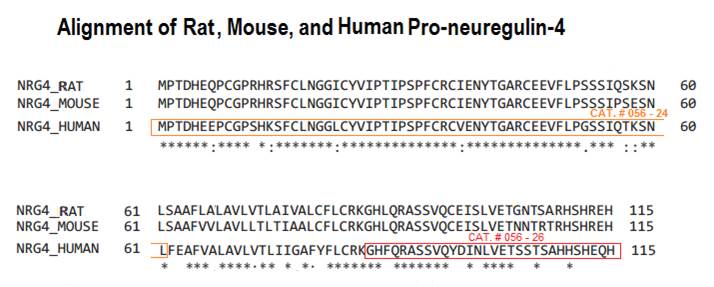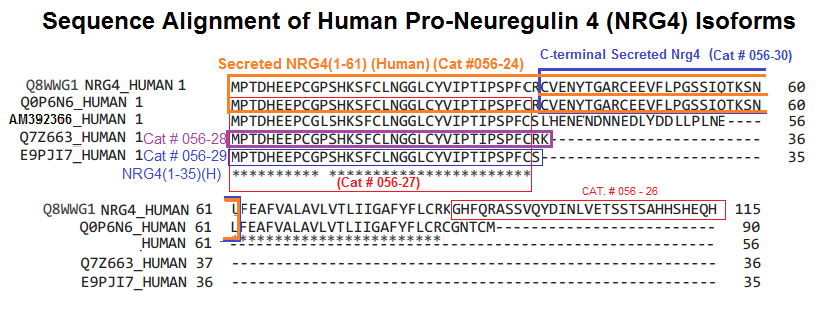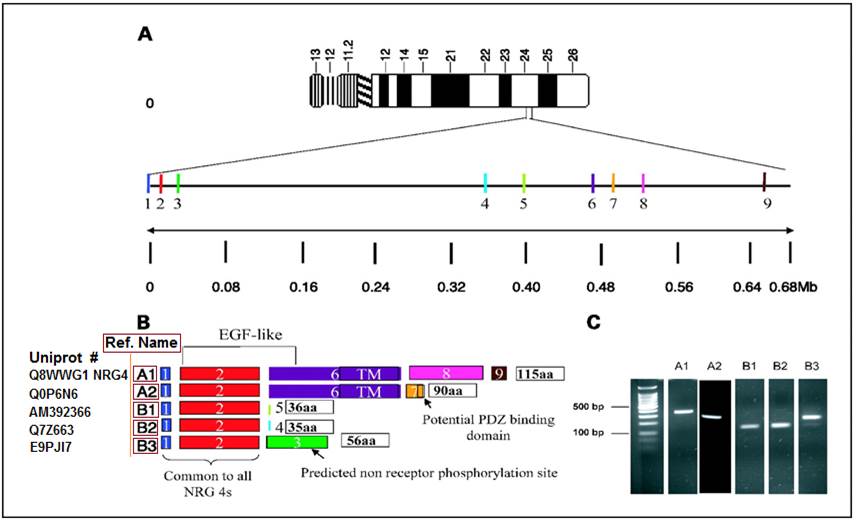

OBJECTIVE: Recent studies have shown that neuregulin 4 (Nrg4), a member of the epidermal growth factor (EGF) family of extracellular ligands, plays an important role in the prevention of obesity, insulin resistance and nonalcoholic fatty liver disease (NAFLD). Considering that thyroid hormone (TH) has profound effects on whole-body energy metabolism, we speculate that circulating Nrg4 levels might be altered in patients with hyperthyroidism.DESIGN AND METHODS: A total of 129 hyperthyroid patients and 100 healthy subjects were recruited. Of them, 39 hyperthyroid patients received thionamide treatment for 3 months until euthyroidism. Serum Nrg4 levels were determined using the ELISA method. To further confirm the relationship between TH and Nrg4, C57BL/6 mice were treated with T3 and quantitative real-time PCR was performed to detect Nrg4 gene expression.RESULTS: Serum Nrg4 levels were significantly elevated in hyperthyroid patients as compared with normal controls (3.84 ± 1.63 vs 2.21 ± 1.04 ng/mL, P < 0.001). After achieving euthyroidism by thionamide treatment, serum Nrg4 levels dropped markedly from 3.57 ± 1.26 to 1.94 ± 0.72 ng/ml (P < 0.001). After adjustment for potential confounders, serum Nrg4 levels were independently associated with hyperthyroidism. The upregulation of Nrg4 expression in the livers and white adipose tissues by T3 was further confirmed by animal and cell culture experiments.CONCLUSIONS: Serum Nrg4 levels were increased in patients with hyperthyroidism. The liver and white adipose tissue might be primary sources contributing to elevated serum Nrg4 concentrations.This publication used the NRG4 EIA kit (EK-056-24) from Phoenix Pharmaceuticals.
Li M, Chen Y, Jiang J, et al. Elevated serum neuregulin 4 levels in patients with hyperthyroidism. Endocr Connect. 2019;8(6):728-735.
Neuregulin-4 (Nrg4) is a newly discovered adipokine that is synthesized in many tissues and plays an important role in modulating systemic energy metabolism and in the development of metabolic disorders. However, little is known about the relationship between Nrg4 and coronary artery disease (CAD). In this study, we investigated the association between Nrg4 and the presence and severity of CAD.We enrolled 73 patients diagnosed by coronary angiography (CAG) as having CAD and 32 controls. The CAD group was divided into two subgroups according to their SYNTAX score. Plasma levels of Nrg4 were measured in all participants and compared among different groups. The relationship between Nrg4 and CAD was analyzed. Receiver operating characteristic (ROC) analysis was conducted to evaluate the usefulness Nrg4 in assessing the presence and severity of CAD.Nrg4 levels were negatively associated with the SYNTAX score (r = -0.401, P = 0.000). The patients with a higher SYNTAX score had significantly lower Nrg4 levels as compared with the low SYNTAX score subgroup and the controls (P < 0.05). The Nrg4 levels of the low SYNTAX score subgroup were much lower than controls (P < 0.05). Furthermore, an association between Nrg4 and CAD (odds ratio, 0.279; 95% confidence interval, 0.088-0.882) was observed. Nrg4 had 43.8% sensitivity and 96.9% specificity for identifying CAD, and 73.1% sensitivity and 87.3% specificity for identifying patients who had severe coronary arterylesions.Nrg4 levels were found to be inversely associated with the presence and severity of CAD.This publication used the NRG4 EIA kit (EK-056-24) from Phoenix Pharmaceuticals.
Tian QP, Liu ML, Tang CS, Xue L, Pang YZ, Qi YF. Association of Circulating Neuregulin-4 with Presence and Severity of Coronary Artery Disease. Int Heart J. 2019;60(1):45-49.
PURPOSE: The neuregulin (NRG) 1, 2, and 3 genes undergo extensive alternative mRNA splicing, which results in variants that show structural and functional diversity. The aims of this study were to establish whether the fourth member of this family, NRG4, is expressed in prostate cancer, if it is alternatively spliced and whether any functional differences between the variants could be observed.EXPERIMENTAL DESIGN: The expression of NRG4 was determined using immunohistochemical staining of 40 cases of primary prostate cancer. Bioinformatic analysis and reverse transcription-PCR (RT-PCR) using NRG4 isotype-specific primers on a panel of normal and prostate cancer cell lines were used to identify alternatively spliced NRG4 variants. Expression of these variants was determined using isotype-specific antibodies. Transfection into Cos-7 cells of two of these green fluorescent protein-tagged variants allowed analysis of their subcellular location. Four of thevariants were chemically synthesized and tested for their ability to activate the ErbB4 receptor.RESULTS: NRG4 was variably expressed in the cytoplasm in the majority of prostate cancer cases, and in a subset of cases in the membrane, high levels were associated with advanced disease stage. Four novel NRG4 splice variants (NRGA2, NRG4 B1-3) were characterized, where each seemed to have a different subcellular location and were also expressed in the cytoplasm of the prostate tumors. NRG4 B3 was also present in endothelial cells. In transfected cells, the A type variant (NRG4 A1) was localized to the membrane, whereas the B type variant (NRG4 B1), which lacks the predicted transmembrane region, had an intracellular localization. Only the variants with an intact epidermal growth factor-like domain activated ErbB4 signaling.CONCLUSION: NRG4 overexpression is associated with advanced-stage prostate cancer. The alternative splice variants may have different roles in cell signaling, some acting as classic receptor ligands and some with as-yet unknown functions.Hayes NV, Blackburn E, Smart LV et al., Clin Cancer Res. 2007 Jun 1;13(11):3147-55.

| Catalog# | Product | Standard Size | Price |
|---|---|---|---|
| 056-27 | Neuregulin 4 (Nrg4) (1-34) (Human) | 100 µg | $356 |
| 056-32 | Neuregulin 4 (Nrg4) / Pro-neuregulin-4 (Rat) | 100 µg | $436 |
| 056-35 | Neuregulin 4 (Nrg4) / Pro-neuregulin-4 (mouse) | 100 µg | $436 |
| 056-24 | Neuregulin 4 (Nrg4) / pro-Neuregulin 4 (1-61) (Human) | 100 µg | $444 |
| H-056-24 | Neuregulin 4 (Nrg4) / pro-Neuregulin 4 (1-61) (Human) - Antibody | 50 µl | $571 |
| EK-056-24 | Neuregulin 4 (Nrg4) / pro-Neuregulin 4 (1-61) (Human) - EIA Kit | 96 wells | $624 |
| MB-056-24 | Neuregulin 4 (Nrg4) / pro-Neuregulin 4 (1-61) (Human) - MagBead (Magnetic Bead Linked Antibody) | 1 ml | $796 |
| RK-056-24 | Neuregulin 4 (Nrg4) / pro-Neuregulin 4 (1-61) (Human) - RIA Kit | 125 tubes | $1003 |
| WBK-056-24 | Neuregulin 4 (Nrg4) / pro-Neuregulin 4 (1-61) (Human) - Western Blot Kit | 1 kit | $777 |
| MRK-056-24 | Neuregulin 4 (Nrg4) / pro-Neuregulin 4 (1-61) (Human) – Magnetic Bead RIA Kit | 125 tubes | $1003 |
Social Network Confirmation